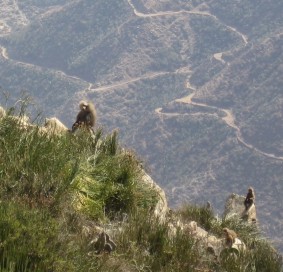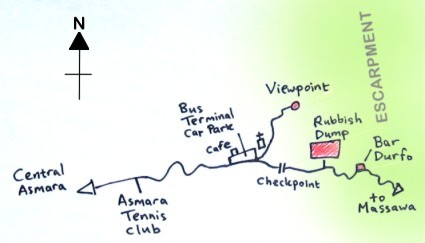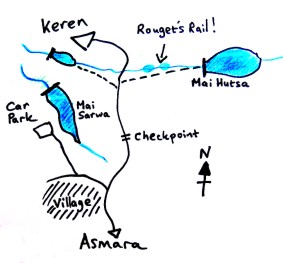|
Birdwatching in Eritrea Asmara and Environs |
||
| Home |
Introduction At over 2300m, Asmara is one of the highest capital cities in the world. It is in the Abyssinian highlands and so several of the Abyssinian endemic species can be seen here. It is a good base from which to visit all the other parts of Eritrea. In addition to this, a wide range of habitats can be found within a short drive of the city, including several very good reservoirs for birdwatching, irrigated agricultural land, rocky highland plains and the steep escarpment edge - a good place to look for raptors, especially during migration seasons.
Accommodation See Travel and Accommodation page.
Habitat Types Urban parks and gardens, agricultural plains including irrigated land, rocky highland plains, Eucalyptus forest, reservoirs, stream valleys with native tree and shrub species, steep escarpment mountains with scrub vegetation.
Birdwatching Highlights of the Asmara Area Several of the Abyssinian endemic species can be found within 20km of Asmara, including Rouget's Rail at Mai Hutsa and Wattled Ibis near Radar Dam. Others such as Thick-billed Raven and White-throated Seed-eater have been recorded in the area. Several reservoirs are recommended including Mai Hutsa, Mai Sarwa, Radar, Mai Nefe, Acria, Adi Nfas and Valanecke where a good range of waterbirds can be found, such as Black-headed Heron, Black-crowned Night Heron, Squacco Heron, Yellow-billed Stork, African Spoonbill, Hammerkop, African Sacred Ibis and Pink-backed Pelican as well as a large number of waterfowl, including Maccoa Duck and good numbers of migrating and wintering waders and ducks from October to April. The agricultural lands support a range of interesting species, including Black-shouldered Kite, Yellow-mantled Widowbird, Pin-tailed Whydah, Red-rumped Waxbill, Northern Bishop, Southern Grey Shrike and Ruppell's Weaver to name but a few. Perhaps the highlight of the area is the eastern escarpment edge where significant numbers of raptors can be seen, especially during migration months with counts of over 100 Steppe Eagles being recorded at Asmara's permanently-burning rubbish dump, along with Tawny Eagle, Eastern Imperial Eagle, Booted Eagle, Lesser Spotted Eagle, Wahlberg's Eagle, African Hawk Eagle and even Verreaux's Eagle. Black Kite are common here, along with Lanner and Peregrine Falcon. Keep an eye out for the large troops of Hamadyas Baboons here, too!
Where to Watch Birds
The escarpment edge, Asmara rubbish dump and Bar Durfo Take the main road to Massawa out of Asmara. On the outskirts of the city you will pass the Asmara Tennis Club on your right and then pass through eucalyptus forests for a couple of kilometres. Suddenly you'll see a big tarmac area on your left, where you can park, just before you come to the first checkpoint located near the edge of the escarpment. If you want to take the bus, catch the number 1 from outside the cathedral in the town centre going towards September Square. The tarmac 'car park' is the last stop on the route. Buses go about every 30 minutes and cost 1Nfa.
From this 'car park' the escarpment edge is obvious to the east, where you will see a pretty little orthadox church on the top of a small hill. Walk towards this church following the path just to the right of it, and then turn to the left, under the church and past the cemetery. Continue down to the edge of the escarpment. From here you should have good views of the Asmara Rubbish Dump to your right and scrub covered hillside to your left, and hopefully, plenty of raptors in front of you! You can choose where to go from here. It is possible to cross over to the Rubbish Dump on foot, or alternatively you can go through the checkpoint (if you have a Massawa or Ghinda permit; see Travel and Accommodation) and park by the rubbish dump, about another kilometre beyond the checkpoint on the left. The rubbish dump is very good for raptors, as mentioned above. A stroll towards the rubbish dump will lead to a small valley with small acacia, where there is a nice range of species, including lots of migrants in spring and autumn. Hamadryas baboon troops of over 100 are common here. They often travel south to the rubbish dump to feed at dawn, moving back north mid-morning.
If you pass through the checkpoint, there is a cafe a little further along the Massawa road after the rubbish dump called Bar Durfo. This is an excellent viewpoint for raptors, and you can also see the railway snaking around the hills beneath you. Banded Barbet has been recorded here. Birds: Steppe Eagle, Tawny Eagle, Eastern Imperial Eagle, Booted Eagle, Lesser Spotted Eagle, Wahlberg's Eagle, Verreaux's Eagle, African Hawk Eagle, Black Kite, Common Buzzard, Augur Buzzard, Lanner, Peregrine Falcon, Common Kestrel, Abdim's Stork, Nyanza Swift, White-rumped Swift, Alpine Swift, White-rumped Babbler, Banded Barbet. Migrants that are seen in spring and autumn include Common Cuckoo, Ortolan Bunting, Wryneck, Golden Oriole, Eurasian Hoopoe, Eurasian Bee-eater, Red-backed Shrike, Woodchat Shrike, Red-tailed (Isabelline) Shrike, Whitethroat and several swallow species, including Red-rumped Swallow and House Martin.
Radar Dam and nearby irrigated agricultural lands Radar Dam is within walking distance of the centre of Asmara, or a 10 minute drive if you prefer. From the town centre take the road that goes west from the President's Palace (with the Palace on your left) which will lead you up towards a rocky hill. The road skirts to the right just before the hill, leading to Keren. Follow it to the right and then take a left at a gas station here to keep heading west. You will see the long pointed radar in front of you. There are several back roads that lead up to the reservoir. Water levels can get very low from March-July, so the reservoir is more productive from September to January. The agricultural lands downstream of the reservoir are also productive, with a small resident party of Wattled Ibis, along with Northern Red Bishop, Spur-winged Lapwing, Yellow-mantled Widowbird, African Quailfinch, Zitting Cisticola and Pectoral Patch Cisticola. Plenty of migrants turn up here in spring and autumn, including Collared Pratincole and huge numbers of Ruff. Birds: Little Grebe, Great-crested Grebe, Pink-backed Pelican, Black-headed Heron, Cattle Egret, Squacco Heron, Hammerkop, Yellow-billed Stork, White Stork, Abdim's Stork, Glossy Ibis, Wattled Ibis, Sacred Ibis, Garganey, Gadwall, Northern Pintail, Northern Shoveler, Black-shouldered Kite, Tawny Eagle, Collared Pratincole, Black-winged Stilt, Spur-winged Lapwing, Little Stint, Temmick's Stint, Curlew Sandpiper, Ruff, Black-tailed Godwit, Marsh Sandpiper, Green Sandpiper, Wood Sandpiper, Redshank, Greenshank, Ethiopian Swallow, Sand Martin, Yellow Wagtail, Pectoral Patch Cisticola, Zitting Cisticola, Cape Crow, African Citril, Northern Red Bishop, Yellow-mantled Widowbird, Eurasian Hoopoe, Groundscraper Thrush, Red-rumped Waxbill, African Quailfinch
Mai
Sarwa Dam and Mai Hutsa (or Valanecke) Dam For Mai Sarwa, take the Keren road north out of Asmara. After about 10 kilometres you will pass through a village (called Adi Ebeito). Just as you come out of the village there will be a rusty sign on the left pointing to the left for the Mai Sarwa Recreation Area. Turn left here and follow the signs to the reservoir. Park your car and explore around the reservoir. Don't forget to check the forest downstream of the reservoir, which often turns up some interesting species. If possible try to get here early in the morning, as wedding parties tend to flood the reservoir during the day, especially at weekends.
To get to Mai Hutsa, which is also called Valanecke, go back to the main road and turn left (north) towards Keren. A few kilometres further on (past a small customs checkpoint) the road will drop into a shallow stream valley, with eucalypt all around. Just before the valley, there is a dirt road through a gate to the right. This road leads up to Mai Hutsa reservoir. You need a special permit to visit the reservoir, but Solomon Abraha (see Travel and Accommodation or Contacts pages) should be able to get you there. Alternatively, there are some good forests just through the gate, and downstream of the main road (where there is another smaller reservoir). This valley is a good spot to find Rouget's Rail.
Further along the road to Keren, the next village is called Emba Derho, which also has a productive reservoir, where large numbers of migrants can be found, and where there was a report of Abyssinian Longclaw a few years ago. Black Saw-wing and Wire-tailed Swallow can also be found here occasionally.
Birds: Little Grebe, Great-crested Grebe, Reed Cormorant, Pink-backed Pelican, Black-crowned Night Heron, Grey Heron, Northern Pintail, Osprey, Black Kite, Yellow-billed Kite, Common Buzzard, Booted Eagle, Long-crested Eagle, Rouget's Rail, Common Moorhen, Red-knobbed Coot, Common Sandpiper, Namaqua Dove, Vinaceous Dove, Woodland Kingfisher, Pied Kingfisher, Blue-breasted Bee-eater, Yellow-breasted Barbet, White-rumped Babbler, Willow Warbler, Chiff Chaff, Singing Cisticola, Black-backed Cisticola, Tacazze Sunbird, Beautiful Sunbird, Baglafecht Weaver, Village Weaver, Village Indigobird, Streaky Seed-eater
Mai
Nefe
Dam Mai Nefe is probably the largest reservoir in Eritrea, so it attracts good species all year round, including significant numbers of Egyptian Goose and Pink-backed Pelican. Great Crested Grebe breed here, and during migration season large numbers of waders and wildfowl pass through. Vagrants are likely. Although it is a long way out of Asmara, there are no checkpoints along the way, and the road is fairly flat, so it makes an enjoyable day's cycling journey from Asmara. To get to Mainefe, take the Mendefera road south west out of Asmara. You will go past the airport on your right. The first village you pass through is Adi Guaedad. Just after the village is a turning to the right (tarmacked road), which leads to several villages including Mai Nefi. Follow this road through two small villages (you will pass Kebesa/Chiwa Junior School on your left). After about 20-23km out of Asmara, glimpses of the reservoir will start to show to the right of the road down in a valley. Park anywhere and walk down. The best birds are at the shallow end (eastern) of the reservoir. Bus number 12 also goes down here from the centre of Asmara. Birds: Little Grebe, Great-crested Grebe, Great Cormorant, Long-tailed Cormorant, Little Egret, Grey Heron, Yellow-billed Stork, African Spoonbill, Pink-backed Pelican, Common Pochard, Tufted Duck, Osprey, Montagu's Harrier, Tawny Eagle, Steppe Eagle, Booted Eagle, Augur Buzzard, Greenshank, Three-banded Plover, African Grey Hornbill, Thelka Lark, Red-rumped Swallow, Shining Sunbird
Acria and Adi Nfas Dam These 2 good dams are located north east of Asmara. There is no main road that leads there, but you can take the road north from the Keren bus station until you come to the terminal bus stop for the number 8 bus. From here a dirt road heads north past Eucalypt forests and brick kilns until you come to the small but very productive Acria Reservoir, which can be teeming with migrants especially in the autumn. Continue along the road to get to Adi Nfas reservoir, which is also usually good. There is another reservoir north of Adi Nfas, also productive, with copses of acacia woodland around it. At Acria there are several glue/soap processing factories here and large numbers of raptors are attracted by the smell and congregate to feed on the animal remains. Particularly in February and March large numbers of migrating Aquila eagles can be observed here, especially Steppe, Tawny and Lesser Spotted Eagle along with Booted Eagle and African Hawk Eagle. Large numbers of raptors roost in the Eucalyptus forests east of the road. Birds: Little Grebe, Great-crested Grebe, Black-headed Heron, Squacco Heron, Little Egret, Cattle Egret, Yellow-billed Stork, Abdim's Stork, Greater Flamingo, Garganey, Eurasian Wigeon, Common Teal, Northern Pintail, Northern Shoveler, Common Pochard, Ferruginous Duck, Tufted Duck, Maccoa Duck, Black Kite, Augur Buzzard, Tawny Eagle, Steppe Eagle, Lesser Spotted Eagle, Booted Eagle, African Hawk Eagle, African Harrier Hawk, Lesser Kestrel, Lanner Falcon, Black-winged Stilt, Three-banded Plover, Ruff, Marsh Sandpiper, Wood Sandpiper, Green Sandpiper, Common Sandpiper, Redshank, White-winged Tern, Blue-breasted Bee-eater, European Bee-eater, Yellow-breasted Barbet, Eurasian Hoopoe, Thelka Lark, Yellow Wagtail, White-throated Robin (Irania), Isabelline Wheatear, Mocking Cliff-chat, Whitethroat, Spotted Flycatcher, Fiscal Shrike, Tacazze Sunbird, Pale Rock Finch, Yellow-bellied Waxbill, African Citril, Streaky Seed-eater.
|
|
| Eritrea Information | ||
| Abyssinian Endemics | ||
| Bird Checklist for Eritrea | ||
| Travel & Accommodation | ||
| In Italiano | ||
| Photos | ||
| Other Wildlife | ||
| Asmara Birdwatching | ||
| Filfil Birdwatching | ||
| Adi Keih Birdwatching | ||
| Massawa Birdwatching | ||
| Dahlak Islands Birdwatching | ||
| Elabered / Keren Birdwatching | ||
| Gash Barka Birdwatching | ||
| Contacts and Services | ||
| Links | ||
| Children and Schools | ||
|
|
||
|
|
||



